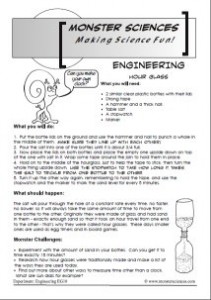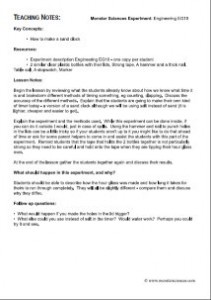I bet you never thought you could build your own clock, but you can, of sorts! This version of a sand clock works in exactly the same way as traditional hour glasses and is a fun engineering experiment for your students.
 |
 |
Engineering Experiment: Make an hour glass
What you will need:
• 2 similar clear plastic bottles with their lids
• Strong tape
• A hammer and a thick nail
• Table salt
• A stopwatch
• Marker
What you will do:
1. Put the bottle lids on the ground and use the hammer and nail to punch a whole in the middle of them. Make sure they line up with each other!
2. Pour the salt into one of the bottles until it is about 3/4 full.
3. Now place the lids on both bottles and place the empty one upside down on top of the one with salt in it. Wrap some tape around the join to hold them in place.
4. Hold on to the middle of the hourglass, just to help the tape to stick, then turn the whole thing upside down. use the stopwatch to time how long it takes the salt to trickle from one bottle to the other.
5. Turn it up the other way again, remembering to hold the tape, and use the stopwatch and the marker to mark the sand level for every 5 minutes.
What should happen:
The salt will pour through the hole at a constant rate every time, no faster, no slower, so it will always take the same amount of time to move from one bottle to the other. Originally they were made of glass and had sand in them – exactly enough sand so that it took an hour travel from one end to the other – that’s why they were called hour glasses. These days smaller ones are used as egg timers and in board games.
Monster Challenges:
• Experiment with the amount of sand in your bottles. Can you get it to time exactly 15 minutes?
• Research how hour glasses were traditionally made and make a list of the ways they are used today.
• Find out more about other ways to measure time other than a clock. What are sun dials for example?
Teaching Notes: Monster Sciences Experiment: Engineering EG10
Key Concepts:
• How to make a sand clock
Resources:
• Experiment description Engineering EG10 – one copy per student
• 2 similar clear plastic bottles with their lids, Strong tape, A hammer and a thick nail, Table salt, A stopwatch, Marker
Lesson Notes:
Begin the lesson by reviewing what the students already know about how we know what time it is and brainstorm different methods of timing something, eg counting, clapping. Discuss the accuracy of the different methods. Explain that the students are going to make their own kind of timer today – a version of a sand clock although we will be using salt instead of sand (it is lighter, cheaper and easier to get).
Explain the experiment and the methods used. While this experiment can be done inside, if you can do it outside I would, just in case of spills. Using the hammer and nail to punch holes in the lids can be a little tricky so if your students aren’t up to it you might like to do that ahead of time or ask for some parent helpers to come in and assist the students with this part of the experiment. Remind students that the tape that holds the 2 bottles together is not particularly strong so they need to be careful and hold onto the tape when they are tipping their hour glass over.
At the end of the lesson gather the students together again and discuss their results.
What should happen in this experiment, and why?
Students should be able to describe how the hour glass was made and how long it takes for theirs to run through completely. They will all be slightly different – compare them and discuss why they differ.
Follow up questions:
• What would happen if you made the holes in the lid bigger?
• What else could you use instead of salt in the timer? Would water work? Perhaps you could try it and see.



